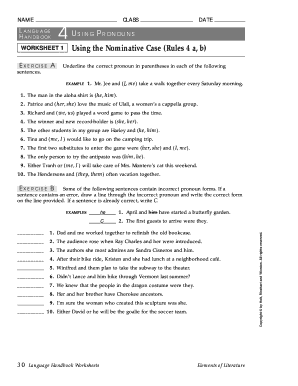Loading

Get Handbook Using The Nominative Case Rules 4 A B - Cibacs
How it works
-
Open form follow the instructions
-
Easily sign the form with your finger
-
Send filled & signed form or save
How to fill out the Handbook Using The Nominative Case Rules 4 A B - Cibacs online
This guide will assist users in completing the Handbook Using The Nominative Case Rules 4 A B - Cibacs with clarity and efficiency. The handbook is designed to enhance understanding of nominative case rules through a series of engaging exercises.
Follow the steps to accurately complete your handbook online.
- Click ‘Get Form’ button to access the handbook and open it in your preferred editor.
- Begin with Exercise A, where you will underline the correct pronoun in parentheses for each provided sentence. Ensure to read each sentence carefully to select the appropriate pronoun.
- Proceed to Exercise B, where some sentences may contain incorrect pronoun forms. Draw a line through the incorrect pronoun and write the correct form on the line provided. If a sentence is correct, indicate it by writing 'C'.
- Once you have filled in all sections, review your answers to ensure accuracy and completeness.
- Finally, save your changes, and if needed, download the document, print it, or share it as required.
Start completing your Handbook online to enhance your understanding of nominative case rules.
What is the nominative case? The nominative case refers to the noun or pronoun that appears as the subject of the verb in a particular sentence. In other words, the 'nominative case' denotes that the specific noun or pronoun is the subject of the sentence.
Industry-leading security and compliance
US Legal Forms protects your data by complying with industry-specific security standards.
-
In businnes since 199725+ years providing professional legal documents.
-
Accredited businessGuarantees that a business meets BBB accreditation standards in the US and Canada.
-
Secured by BraintreeValidated Level 1 PCI DSS compliant payment gateway that accepts most major credit and debit card brands from across the globe.


